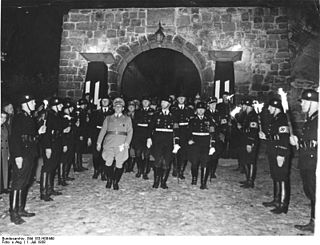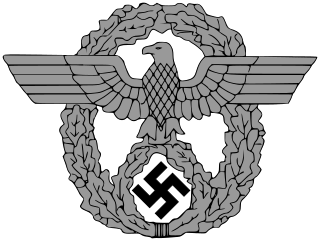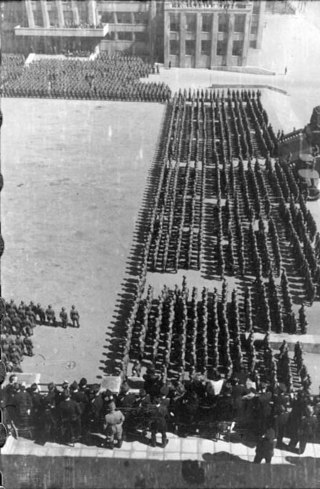Related Research Articles

The Allgemeine SS was a major branch of the Schutzstaffel (SS) paramilitary forces of Nazi Germany; it was managed by the SS Main Office (SS-Hauptamt). The Allgemeine SS was officially established in the autumn of 1934 to distinguish its members from the SS-Verfügungstruppe, which later became the Waffen-SS, and the SS-Totenkopfverbände, which were in charge of the Nazi concentration camps and extermination camps. SS formations committed many war crimes against civilians and allied servicemen.

The Ordnungspolizei, abbreviated Orpo, meaning "Order Police", were the uniformed police force in Nazi Germany from 1936 to 1945. The Orpo organisation was absorbed into the Nazi monopoly on power after regional police jurisdiction was removed in favour of the central Nazi government. The Orpo was controlled nominally by the Interior Ministry, but its executive functions rested with the leadership of the SS until the end of World War II. Owing to their green uniforms, Orpo were also referred to as Grüne Polizei. The force was first established as a centralised organisation uniting the municipal, city, and rural uniformed police that had been organised on a state-by-state basis.

Kurt Max Franz Daluege was chief of the national uniformed Ordnungspolizei of Nazi Germany. Following Reinhard Heydrich's assassination in 1942, he served as Deputy Protector for the Protectorate of Bohemia and Moravia. Daluege directed the German measures of retribution for the assassination, including the Lidice massacre. After the end of World War II, he was extradited to Czechoslovakia, tried, convicted and executed in 1946.

The Deutsche Reichsbahn, also known as the German National Railway, the German State Railway, German Reich Railway, and the German Imperial Railway, was the German national railway system created after the end of World War I from the regional railways of the individual states of the German Empire. The Deutsche Reichsbahn has been described as "the largest enterprise in the capitalist world in the years between 1920 and 1932"; nevertheless its importance "arises primarily from the fact that the Reichsbahn was at the center of events in a period of great turmoil in German history".
The title of SS and Police Leader designated a senior Nazi Party official who commanded various components of the SS and the German uniformed police (Ordnungspolizei), prior to and during World War II in the German Reich proper and in occupied territories.
Polizei is the German word for police. Police in Germany, Austria and Switzerland consist of different agencies. It might refer to:

The Deutsche Reichsbahn or DR(German Reich Railways) was the operating name of state owned railways in the German Democratic Republic, and after German reunification until 1 January 1994.

The Hilfspolizei was a short-lived auxiliary police force in Nazi Germany in 1933. The term was later semi-officially used for various auxiliary organizations subordinated to the Ordnungspolizei as well as various military and paramilitary units set up during World War II in German-occupied Europe.

The Hamburg Police is the German Landespolizei force for the city-state of Hamburg. Law enforcement in Germany is divided between federal and state (Land) agencies. A precursor to the agency, the Polizei-Behörde, has existed since 1814.

The Schutzpolizei des Reiches or the Schupo was the state protection police of Nazi Germany and a branch of the Ordnungspolizei. Schutzpolizei is the German name for a uniformed police force. The Schutzpolizei des Reiches was the uniformed police of most cities and large towns. State police departments were in charge of protection police, Kripo criminal investigation divisions (Kriminalpolizei), and administrative police. The state protection police comprised a patrol branch, barracked police, traffic police, water police, mounted police, police communications units, and police aviation. Policemen were required to have previous military service, good physical and mental health, Aryan descent and membership in the Nazi Party.

Adolf Hitler, the dictator of Nazi Germany, initiated World War II in Europe with the invasion of Poland in September 1939 and was central to the Holocaust. He was hated by his persecuted enemies and even by some of his own countrymen. Although attempts were made to assassinate him, none were successful. Hitler had numerous bodyguard units over the years which provided security.
Kriminalpolizei, often abbreviated as Kripo, is the German name for a criminal investigation department. This article deals with the agency during the Nazi era.

Feuerschutzpolizei was a fire police unit in Nazi Germany and a branch of Nazi Germany's Ordnungspolizei, formed in 1938 when the German municipal professional fire brigades were transferred to the national police. The previously red fire vehicles, blue uniforms and fire service ranks were replaced by green fire vehicles, green uniforms and police ranks.

The Reich Ministry of Transport was a cabinet-level agency of the German government from 1919 until 1945, operating during the Weimar Republic and Nazi Germany. Formed from the Prussian Ministry of Public Works after the end of World War I, the RVM was in charge of regulating German railways, roadways, waterways, and the construction industry - a kind of infrastructure agency in today's understanding. In the 1920s, the Ministry's involvement in the rail sector was limited to administrative and technical supervisory functions. The National Railway was initially organized as an independent state-owned company to guarantee that Germany paid war reparations according to the provisions of the 1924 Dawes Plan.
The Police Battalion 322 was a formation of the German Order Police during the Nazi era. During Operation Barbarossa, it was subordinated to the SS and deployed in German-occupied areas, specifically the Army Group Centre Rear Area, of the Soviet Union, as part of Police Regiment Centre.
The Police Battalion 316 was a formation of the Order Police during the Nazi era. During Operation Barbarossa, it was subordinated to the SS and deployed in German-occupied areas, specifically the Army Group Centre Rear Area, of the Soviet Union, as part of Police Regiment Centre. Alongside detachments from the Einsatzgruppen and the SS Cavalry Brigade, it perpetrated mass murder in the Holocaust and was responsible for large-scale crimes against humanity targeting civilian populations under the guise of "anti-partisan" warfare. In mid-1942, the battalion was reassigned to the 4th Police Regiment and operated in Slovenia.
The Police Battalion 307 was a formation of the Order Police during the Nazi era. During Operation Barbarossa, it was subordinated to the SS and deployed in German-occupied areas, specifically the Army Group Centre Rear Area, of the Soviet Union, as part of Police Regiment Centre. Alongside detachments from the Einsatzgruppen, it perpetrated mass murder in the Holocaust and was responsible for large-scale crimes against humanity targeting civilian populations. In mid-1942, the battalion was reassigned to the 23rd Police Regiment and operated in Belarus.
Luftschutzpolizei (LSP)(Air Raid Protection Police) was the local civil defense organization in Nazi Germany.

The Order Police battalions were militarised formations of the German Order Police during the Nazi era. During World War II, they were subordinated to the SS and deployed in German-occupied areas, specifically the Army Group Rear Areas and territories under German civilian administration. Alongside detachments from the Einsatzgruppen and the Waffen-SS, these units perpetrated mass murder of the Jewish population and were responsible for large-scale crimes against humanity targeting civilian populations.
The Ranks and insignia of German Women's Auxiliary Services were the ranks given to women who served in the German military and paramilitary forces during World War II.
References
- ↑ Uniformen vom Bahnschutz/Bahnschutzpolizei 1926 bis 1945 Archived 2014-08-15 at the Wayback Machine 2012-01-09
- ↑ Bahnschutz 2012-01-09
- ↑ Gordon Williamsson, World War II German Police Units (2006), p. 37.